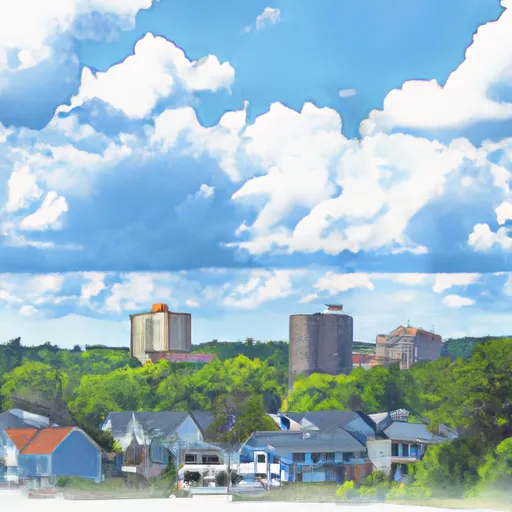-
 Snoflo Premium
Snoflo Premium
Get unlimited access to all our content
With no Ad interruptions! - Start Your Free Trial Login with existing account
Lake-Ann
Eden Index
Climate
7.1
•
Recreation
8.0
•
Community
0.9
•
Safeguard
5.9/10

Lake Ann is a charming village located in Benzie County, Michigan. Situated amidst picturesque natural surroundings, the area experiences a humid continental climate, characterized by warm summers and cold winters. Summers in Lake Ann are generally pleasant, with average temperatures ranging from 70°F to 80°F. Winter brings snowfall and temperatures that can drop below freezing, making it ideal for winter sports enthusiasts.
The village is named after the beautiful Lake Ann, a 488-acre lake that offers a range of water-based recreational activities. Its hydrology constituents include clear and pristine waters, supporting diverse aquatic life. Anglers can enjoy fishing for species such as bass, pike, and panfish, while boaters and kayakers can explore the serene lake and its peaceful coves.
Aside from Lake Ann, the surrounding area boasts numerous other outdoor recreation opportunities. The nearby Sleeping Bear Dunes National Lakeshore offers stunning sand dunes and scenic hiking trails, perfect for nature lovers. Additionally, the region is home to several golf courses, parks, and trails, providing ample opportunities for biking, hiking, picnicking, and wildlife spotting.
In conclusion, Lake Ann, Michigan, is a captivating village with a pleasant climate, pristine lake, and an abundance of outdoor recreation options.
What is the Eden Index?
The Snoflo Eden Index serves as a comprehensive rating system for regions, evaluating their desirability through a holistic assessment of climate health, outdoor recreation opportunities, and natural disaster risk, acknowledging the profound impact of these factors on livability and well-being.
Climate Health Indicator (CHI): 7.1
Lake-Ann receives approximately
861mm of rain per year,
with humidity levels near 80%
and air temperatures averaging around
8°C.
Lake-Ann has a plant hardyness factor of
6, meaning
plants and agriculture in this region thrive during a short period during spring and early summer. Most
plants will die off during the colder winter months.
By considering the ideal temperature range, reliable water supplies, clean air, and stable seasonal rain or snowpacks, the Climate Health Indicator (CHI) underscores the significance of a healthy climate as the foundation for quality living.
A healthy climate is paramount for ensuring a high quality of life and livability in a region, fostering both physical well-being and environmental harmony. This can be characterized by ideal temperatures, reliable access to water supplies, clean air, and consistent seasonal rain or snowpacks.
Weather Forecast
Streamflow Conditions
Northeastern Lake Michigan
Area Rivers
Northeastern Lake Michigan
Snowpack Depths
Northeastern Lake Michigan
Reservoir Storage Capacity
Northeastern Lake Michigan
Groundwater Levels
Recreational Opportunity Index (ROI): 8.0
The Recreational Opportunity Index (ROI) recognizes the value of outdoor recreational options, such as parks, hiking trails, camping sites, and fishing spots, while acknowledging that climate plays a pivotal role in ensuring the comfort and consistency of these experiences.
Access to outdoor recreational opportunities, encompassing activities such as parks, hiking, camping, and fishing, is crucial for overall well-being, and the climate plays a pivotal role in enabling and enhancing these experiences, ensuring that individuals can engage in nature-based activities comfortably and consistently.
Camping Areas
| Campground | Campsites | Reservations | Toilets | Showers | Elevation |
|---|---|---|---|---|---|
| Ed H. Henning Park | 60 | 700 ft | |||
| Blind Sucker 1 - State Forest | 13 | 634 ft | |||
| Pretty Lake - State Forest | 27 | 761 ft | |||
| Holland Lake - State Forest | 15 | 760 ft | |||
| Blind Sucker 2 - State Forest | 32 | 635 ft | |||
| Fremont Lake City Park | None | 747 ft | |||
| Croton Township Park | None | 679 ft | |||
| Woodland Park | 132 | 628 ft | |||
| Lake Superior - State Forest | 18 | 627 ft | |||
| Brookside City Park | 12 | 705 ft |
Nearby Ski Areas
Catastrophe Safeguard Index (CSI):
The Catastrophe Safeguard Index (CSI) recognizes that natural disaster risk, encompassing floods, fires, hurricanes, and tornadoes, can drastically affect safety and the overall appeal of an area.
The level of natural disaster risk in a region significantly affects safety and the overall livability, with climate change amplifying these risks by potentially increasing the frequency and intensity of events like floods, fires, hurricanes, and tornadoes, thereby posing substantial challenges to community resilience and well-being.
Community Resilience Indicator (CRI): 0.9
The Community Resilience Indicator (CRI) recognizes that education, healthcare, and socioeconomics are crucial to the well-being of a region. The CRI acknowledges the profound impact of these elements on residents' overall quality of life. By evaluating educational resources, healthcare accessibility, and economic inclusivity, the index captures the essential aspects that contribute to a thriving community, fostering resident satisfaction, equity, and social cohesion.

